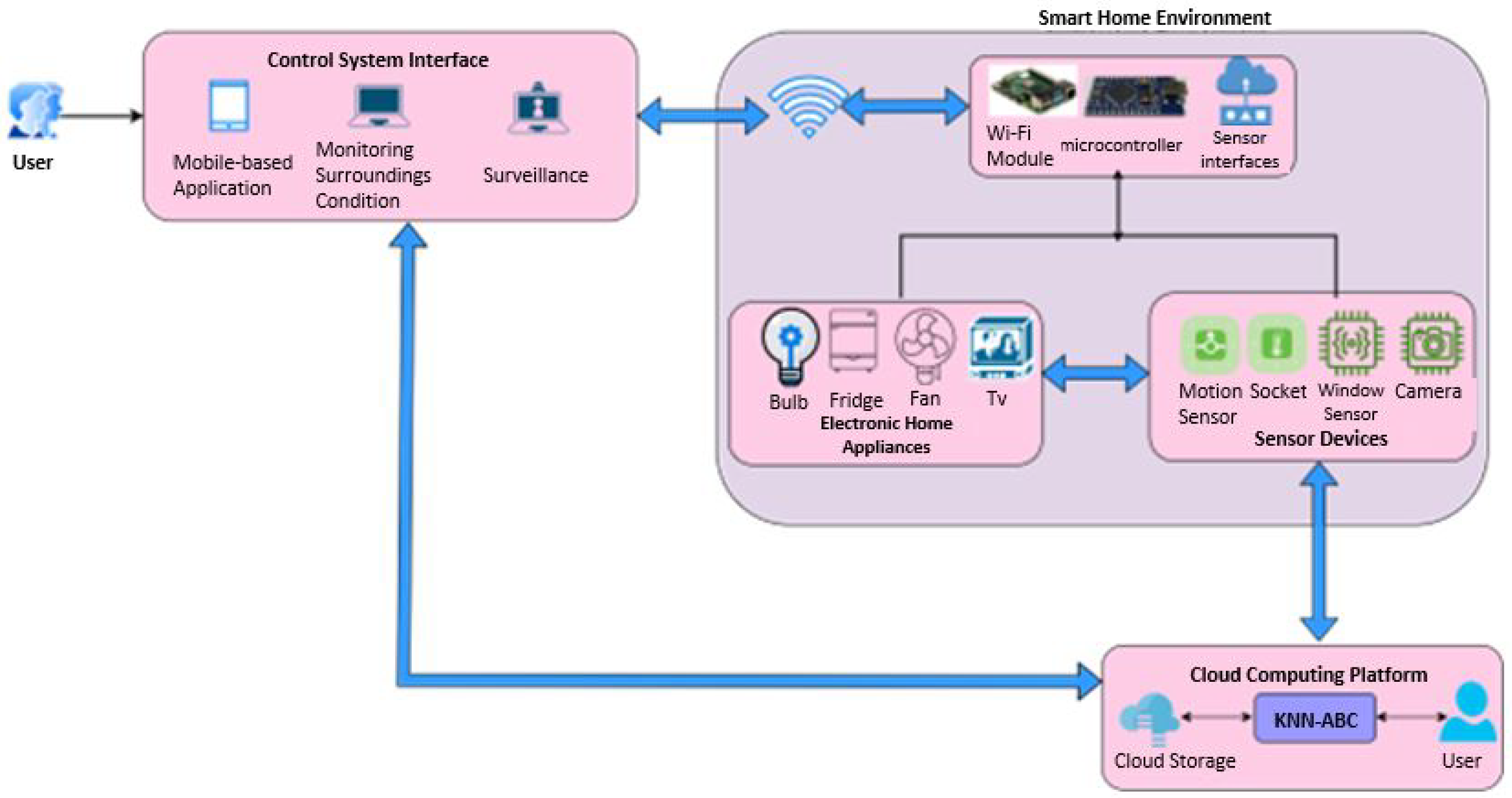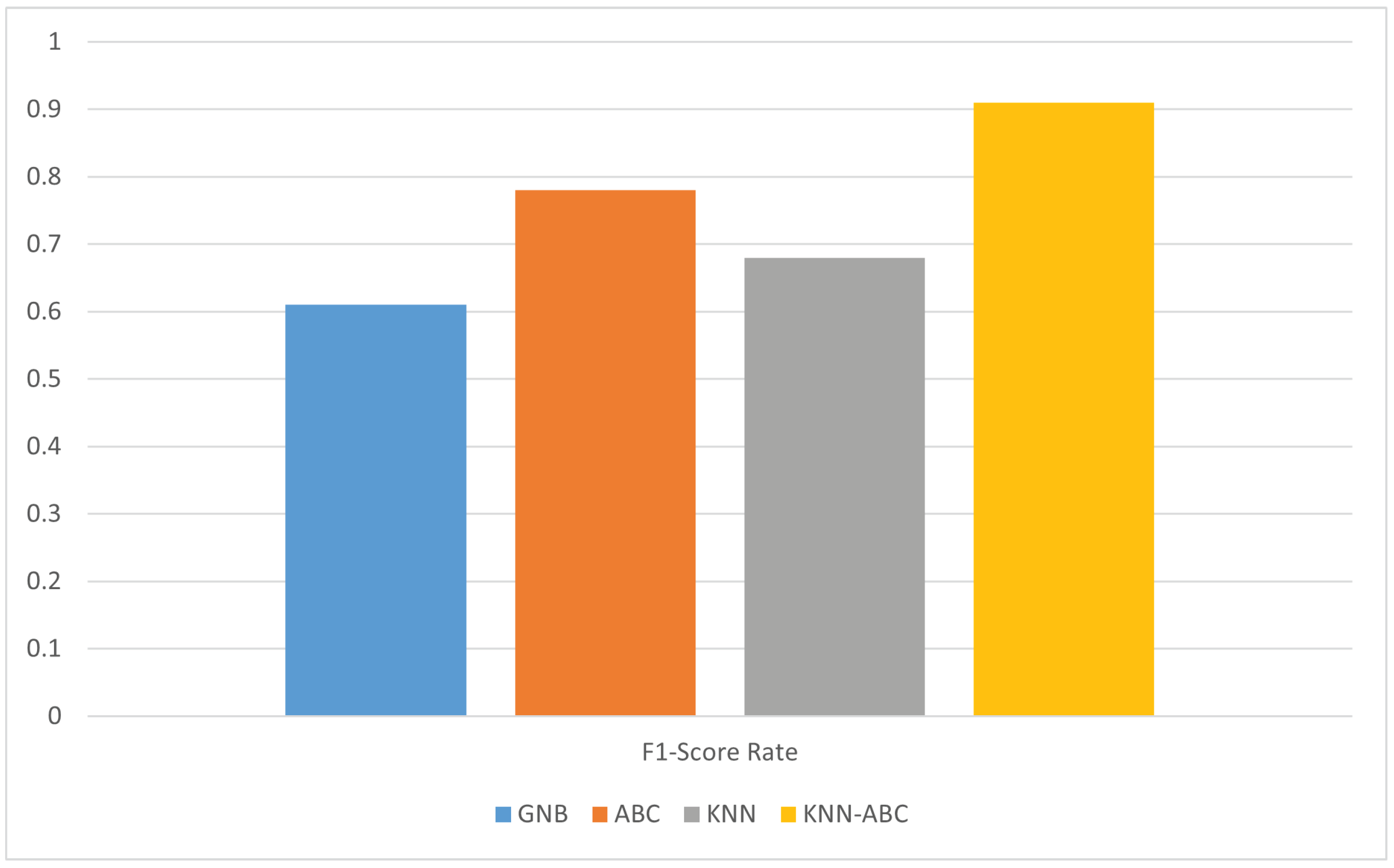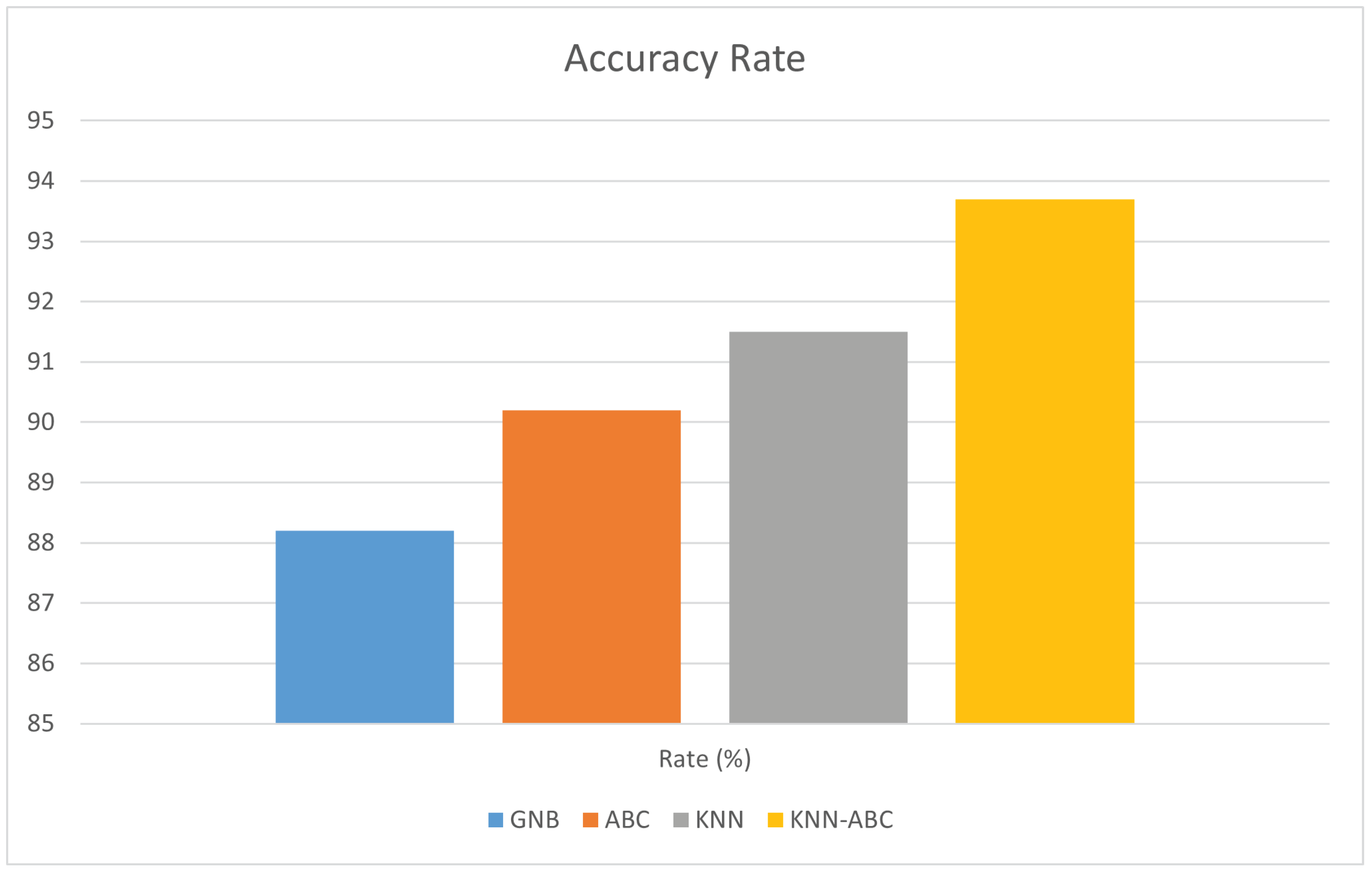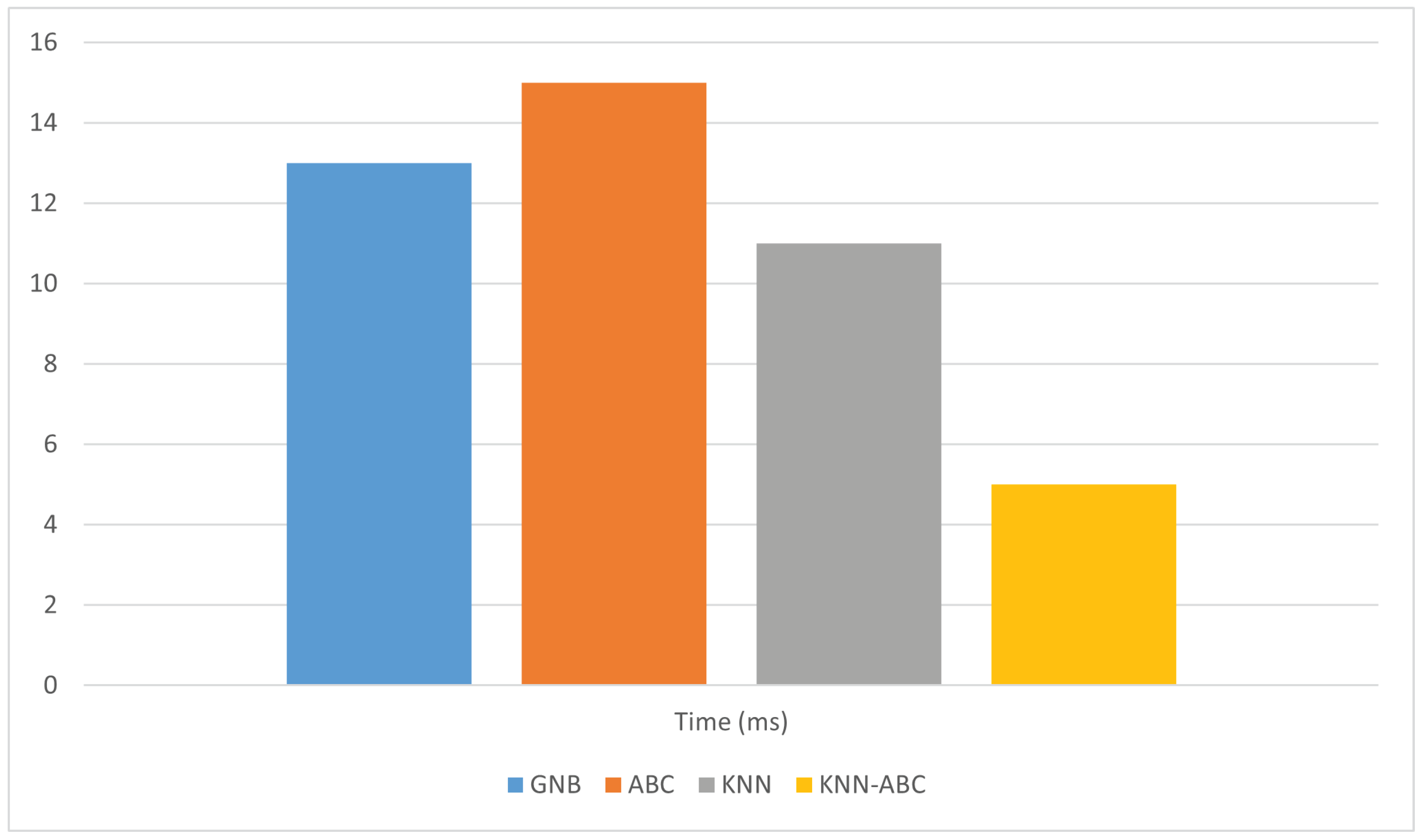Evaluation of IoT-Based Smart Home Assistance for Elderly People Using Robot
Abstract
:1. Introduction
- To implement smart home assistance for elderly people by using the KNN algorithm to monitor the status of electronic home appliances and provide an ON/OFF state using Cyborg.
- To save energy in smart home systems using the Artificial Bee Colony (ABC) algorithm.
- Analysis of the proposed KNN-ABC using the metric measures of precision, recall, F1-score, and accuracy.
2. Related Work
3. Proposed Methodology
3.1. Cyborg in Smart Home Assistance Technology
3.1.1. Control System Interface
3.1.2. Smart Home Environment
3.1.3. Cloud Computing Platform
3.2. K-Nearest Neighbour Algorithm (KNN)
- KNN-1: Used to train the model of KNN-ABC model using dataset.
- KNN-2: Used to evaluate the distance between the user’s location and the coordinate position of value in the dataset, as follows:Here, is the Euclidean distance between the current location and the targeted location in the dataset.
- KNN-3: Sorts all distances in ascending order to select the nearest point.
- KNN-4: The value of is processed by the ABC algorithm as a control input for ON/OFF control of electronic home appliances in the smart home system. It can monitor the sensor signal values using a mobile-based or web-based application.
3.3. Artificial Bee Colony Algorithm for Power Saving in Smart Home System
- ABC 1: Initialize the population size; M is the initial nectar coordinate value and maximum number of iterations.
- ABC 2: Search for a new nectar source by selecting bees from the total number of number of bees N; the bee group size is M, and the spatial dimensionality for bees searching for new nectar sources is S. From the current nectar source, a bee starts its searching process within its neighborhood. The newly created nectar source contains:
- –
- ABC 2.1: The spatial dimension space of the current nectar source is split into regular intervals based on the following formula:where R denotes the h-th interval of point from division of the current nectar source, Q denotes k-th current honey source generated in the l-th dimension space, and Q denotes the n-th current honey source generated in the l-th dimension space.
- –
- ABC 2.2: In each interval of R, the interval is divided into several sub-intervals Y based on the formulawhere R denotes the y-th sub-interval of the current nectar source, denotes the random distribution of values between 0 and 1 at a uniform rate, and denotes the -th interval point produced by division of the next current nectar source.
- –
- ABC 2.3: For every sub-interval of the current nectar source, its fitness function is calculated, then the sub-interval point is selected based on the largest fitness value.
- –
- ABC 2.4: The difference between Q and the fitness value representing the nectar source is evaluated using the following formula:where denotes the difference between Q and the fitness value of the nectar source, represents the fitness value of thee nectar source in the regular interval of R, and denotes the fitness value of R.
- –
- ABC 2.5: is selected as the nectar source, and it is treated as a new source of nectar.
- ABC 3: Compute the fitness value for newly created nectar source compared to the current nectar source.
- ABC 4: Compare the fitness value of the newly created nectar source with the current nectar source.
- ABC 5: Discard the nectar source with the lower fitness value.
- ABC 6: Based on the probability of the nectar source value, select pickers for following the bees.
- ABC 7: For the selected pickers, update the nectar source values.
- ABC 8: For the current nectar source value, search the closest nectar source.
- ABC 9: Repeat steps 2–5 and retain the nectar source with the largest fitness value.
- ABC 10: Increment the iteration.
- ABC 11: Stop the search process when it reaches the maximum iteration and choose the highest fitness value as the coordinate value of the target node in the nectar source.
- KNN-ABC 1: Randomly generate the initial nectar source from the values of M based on the target nectar source of the bees. Based on the target nectar source with the maximum fitness value, randomly generate the initial nectar source values N usingwhere is the l-th initial honey nectar source generated in the k-th dimension spatial space, is the minimum nectar source value of the k-th source of honey, represents the k-th source of honey generated in the spatial dimensional space, and generates random numbers between 0 and 1 and is uniformly distributed in the system.
- KNN-ABC 2: For every nectar source of honey, compute the reverse honey nectar source usingwhere is the the reverse nectar source of honey for the l-th initial generation of honey in the k-th spatial dimensional space.
- KNN-ABC 3: Compute the fitness values for all initial nectar sources as well as for the reverse nectar sources. Based on their fitness values, arrange them in descending order to generate the nectar source value set. The first N nectar honey sources are chosen as the target nodes.
- KNN-ABC 4: To improve the quality of the initial nectar honey source by ensuring an even distribution of nodes in the system, in the smart home environment control system the position of the target node is based on the terms of its speed and stability. This allows for more accurate remote control of all smart electronic home appliances. The fitness value is evaluated usingwhere denotes the fitness value of the nectar honey source F at the position of the l-th beacon node, D denotes the average hop distance which is sent by the first beacon node of nectar Q, denotes the total number of hops between the l-th beacon node and the source of honey, and is the number of beacon nodes.
4. Result and Discussion
5. Conclusions
Funding
Data Availability Statement
Conflicts of Interest
References
- Sumathi, S.; Aditya, S.; Archanaa, B.; Priya, G.L. Cyborg—A Surveillance Droid Using Raspberry Pi and Internet of Things. Int. Res. J. Eng. Technol. 2020, 7, 529. [Google Scholar]
- Wang, C.; Liu, Q.; Xing, L.; Guan, Q.; Yang, C.; Yu, M. Reliability analysis of smart home sensor systems subject to competing failures. Reliab. Eng. Syst. Saf. 2022, 221, 108327. [Google Scholar] [CrossRef]
- Alghayadh, F.; Debnath, D. Hid-smart: Hybrid intrusion detection model for smart home. In Proceedings of the 2020 10th Annual Computing and Communication Workshop and Conference (CCWC), Las Vegas, NV, USA, 6–8 January 2020; IEEE: Piscataway, NJ, USA, 2020; pp. 0384–0389. [Google Scholar]
- Alghayadh, F.; Debnath, D. A hybrid intrusion detection system for smart home security based on machine learning and user behavior. Adv. Internet Things 2021, 11, 10–25. [Google Scholar] [CrossRef]
- Cele, B. Quarter One Crime Statistics, South African Government. 2022. Available online: https://www.gov.za/speeches/minister-bheki-cele-quarter-one-crime-statistics-20222023-19-aug-2022-0000 (accessed on 7 April 2023).
- Taiwo, O.; Ezugwu, A.E. Internet of things-based intelligent smart home control system. Secur. Commun. Netw. 2021, 2021, 1–17. [Google Scholar] [CrossRef]
- Dhanusha, C.; Kumar, A.S. Deep recurrent Q reinforcement learning model to predict the Alzheimer disease using smart home sensor data. In Proceedings of the IOP Conference Series: Materials Science and Engineering; IOP Publishing: Bristol, UK, 2021; Volume 1074, p. 012014. [Google Scholar]
- Gupta, P.; McClatchey, R.; Caleb-Solly, P. Tracking changes in user activity from unlabelled smart home sensor data using unsupervised learning methods. Neural Comput. Appl. 2020, 32, 12351–12362. [Google Scholar] [CrossRef] [Green Version]
- Pattamaset, S.; Choi, J.S. Irrelevant data elimination based on a k-means clustering algorithm for efficient data aggregation and human activity classification in smart home sensor networks. Int. J. Distrib. Sens. Netw. 2020, 16, 1550147720929828. [Google Scholar] [CrossRef]
- Chang, V.; Martin, C. An industrial IoT sensor system for high-temperature measurement. Comput. Electr. Eng. 2021, 95, 107439. [Google Scholar] [CrossRef]
- Gladence, L.M.; Anu, V.M.; Rathna, R.; Brumancia, E. Recommender system for home automation using IoT and artificial intelligence. J. Ambient. Intell. Humaniz. Comput. 2020, 1–9. Available online: https://link.springer.com/article/10.1007/s12652-020-01968-2 (accessed on 7 April 2023).
- Moyle, W.; Murfield, J.; Lion, K. The effectiveness of smart home technologies to support the health outcomes of community-dwelling older adults living with dementia: A scoping review. Int. J. Med Inform. 2021, 153, 104513. [Google Scholar] [CrossRef]
- Mehmood, F.; Ullah, I.; Ahmad, S.; Kim, D. Object detection mechanism based on deep learning algorithm using embedded IoT devices for smart home appliances control in CoT. J. Ambient. Intell. Humaniz. Comput. 2019, 1–17. Available online: https://link.springer.com/article/10.1007/s12652-019-01272-8 (accessed on 7 April 2023).
- Mshali, H.; Lemlouma, T.; Moloney, M.; Magoni, D. A survey on health monitoring systems for health smart homes. Int. J. Ind. Ergon. 2018, 66, 26–56. [Google Scholar] [CrossRef] [Green Version]
- Alghayadh, F.; Debnath, D. A hybrid intrusion detection system for smart home security. In Proceedings of the 2020 IEEE International Conference on Electro Information Technology (EIT), Chicago, IL, USA, 31 July–1 August 2020; IEEE: Bristol, UK, 2020; pp. 319–323. [Google Scholar]
- Thomas, A.; Joseph, G.B.; Augustine, M. CYBORG-The Smart Home Assistance Robot. Int. Adv. Res. J. Sci. Eng. Technol. 2017, 4, 118–120. [Google Scholar] [CrossRef]
- Zheng, R. Indoor smart design algorithm based on smart home sensor. J. Sens. 2022, 2022, 2251046. [Google Scholar] [CrossRef]
- Xiao, G. Machine learning in smart home energy monitoring system. In Proceedings of the IOP Conference Series: Earth and Environmental Science; IOP Publishing: Bristol, UK, 2021; Volume 769, p. 042035. [Google Scholar]
- Zhou, C.; Huang, T.; Liang, S. Smart home R&D system based on virtual reality. J. Intell. Fuzzy Syst. 2021, 40, 3045–3054. [Google Scholar]
- Sharma, P.; Kantha, P. ‘Blynk’ cloud server based monitoring and control using ‘NodeMCU’. Int. Res. J. Eng. Technol. 2020, 7, 1362–1366. [Google Scholar]
- Taiwo, O.; Ezugwu, A.E.; Rana, N.; Abdulhamid, S.M. Smart home automation system using zigbee, bluetooth and arduino technologies. In Proceedings of the Computational Science and Its Applications–ICCSA 2020: 20th International Conference, Cagliari, Italy, 1–4 July 2020; Proceedings, Part VI 20. Springer: Berlin/Heidelberg, Germany, 2020; pp. 587–597. [Google Scholar]
- Soliman, M.S.; Alahmadi, A.A.; Maash, A.A.; Elhabib, M.O. Design and implementation of a real-time smart home automation system based on arduino microcontroller kit and labview platform. Int. J. Appl. Eng. Res. 2017, 12, 7259–7264. [Google Scholar]
- Naing, M.; Hlaing, N.N.S. Arduino based smart home automation system. Int. J. Trend Sci. Res. Dev. 2019, 3, 276–280. [Google Scholar] [CrossRef]
- Manu, R.D.; Kumar, S.; Snehashish, S.; Rekha, K. Smart home automation using IoT and deep learning. Int. Res. J. Eng. Technol. 2019, 6, 1–4. [Google Scholar]
- Saravanan, S.; Nainar, A.; Marichamy, S. Android based smart automation system using multiple authentications. IRE J. 2019, 3, 60–65. [Google Scholar]
- Liao, L.D.; Wang, Y.; Tsao, Y.C.; Wang, I.J.; Jhang, D.F.; Chu, T.S.; Tsao, C.H.; Tsai, C.N.; Chen, S.F.; Chuang, C.C.; et al. Design and validation of a multifunctional android-based smart home control and monitoring system. IEEE Access 2019, 7, 163313–163322. [Google Scholar] [CrossRef]
- Popa, D.; Pop, F.; Serbanescu, C.; Castiglione, A. Deep learning model for home automation and energy reduction in a smart home environment platform. Neural Comput. Appl. 2019, 31, 1317–1337. [Google Scholar] [CrossRef]
- Singh, G.; Pal, Y.; Dahiya, A.K. Classification of Power Quality Disturbances using Linear Discriminant Analysis. Appl. Soft Comput. 2023, 138, 110181. [Google Scholar] [CrossRef]
- Moraes, J.d.; Schaefer, J.L.; Schreiber, J.N.C.; Thomas, J.D.; Nara, E.O.B. Algorithm applied: Attracting MSEs to business associations. J. Bus. Ind. Mark. 2020, 35, 13–22. [Google Scholar] [CrossRef]
- Lin, J.; Yang, J.; Huang, Y.; Lin, X. Defect identification of metal additive manufacturing parts based on laser-induced breakdown spectroscopy and machine learning. Appl. Phys. B 2021, 127, 1–10. [Google Scholar] [CrossRef]
- Thawkar, S.; Sharma, S.; Khanna, M.; kumar Singh, L. Breast cancer prediction using a hybrid method based on Butterfly Optimization Algorithm and Ant Lion Optimizer. Comput. Biol. Med. 2021, 139, 104968. [Google Scholar] [CrossRef] [PubMed]
- Chakraborty, S.; Saha, A.K.; Nama, S.; Debnath, S. COVID-19 X-ray image segmentation by modified whale optimization algorithm with population reduction. Comput. Biol. Med. 2021, 139, 104984. [Google Scholar] [CrossRef]
- Sayed, G.I.; Soliman, M.M.; Hassanien, A.E. A novel melanoma prediction model for imbalanced data using optimized SqueezeNet by bald eagle search optimization. Comput. Biol. Med. 2021, 136, 104712. [Google Scholar] [CrossRef] [PubMed]
- Xing, J.; Zhao, H.; Chen, H.; Deng, R.; Xiao, L. Boosting whale optimizer with quasi-oppositional learning and Gaussian barebone for feature selection and COVID-19 image segmentation. J. Bionic Eng. 2023, 20, 797–818. [Google Scholar] [CrossRef]
- Piri, J.; Mohapatra, P. An analytical study of modified multi-objective Harris Hawk Optimizer towards medical data feature selection. Comput. Biol. Med. 2021, 135, 104558. [Google Scholar] [CrossRef] [PubMed]
- Shen, J.; Fang, H. Human activity recognition using gaussian naive bayes algorithm in smart home. In Proceedings of the Journal of Physics: Conference Series; IOP Publishing: Bristol, UK, 2020; Volume 1631, p. 012059. [Google Scholar]
- Siddiq, M.; Wibawa, I.; Kallista, M. Integrated Internet of Things (IoT) technology device on smart home system with human posture recognition using kNN method. In Proceedings of the IOP Conference Series: Materials Science and Engineering; IOP Publishing: Bristol, UK, 2021; Volume 1098, p. 042065. [Google Scholar]
- Kaghazgarian, M. Activity Recognition with Healthy Older People. 2018. Available online: https://www.kaggle.com/datasets/marklvl/activity-recognition-with-healthy-older-people (accessed on 7 April 2023).






| Author | Technology | Monitoring Function |
|---|---|---|
| Ruili Zheng (2022) [17] | IoT | Indoor smart monitoring and modern lifestyle. |
| X. Gengyi (2021) [18] | Machine Learning algorithm SVM | Energy monitoring in a smart home system |
| C. Zhou et al. (2021) [19] | Virtual Reality | Classifying human activity with R&D |
| P. Sharma et al. (2020) [20] | Cloud server-based NodeMCU | Electricity measurements in a smart home |
| O. Taiwo et al. (2020) [21] | Zigbee, Bluetooth, and Arduino technologies | Health care monitoring system |
| M. S. Soliman et al. (2020) [22] | LabVIEW | PIR Motion Sensor, indoor detection in a smart home |
| M. Naing et al. (2019) [23] | Arduino-based smart home control | Temperature, humidity sensor |
| R. D. Manu et al. (2019) [24] | IoT-based Deep Learning algorithm | Motion sensor, PIR sensor |
| S. K. Saravanan et al. (2019) [25] | Android-based smart home control | Multiple authentication processes, privacy preservation using key generation |
| L. D. Liao et al. (2019) [26] | Android-based smart home control | health care monitoring, multifunctional operating systems |
| D. Popa et al. (2019) [27] | Deep Learning | Energy reduction and power saving |
| Algorithm | Precision | Recall | Sensitivity |
|---|---|---|---|
| GNB | 65.16% | 55.35% | 68.76% |
| ABC | 72.11% | 67.65% | 70.37% |
| KNN | 66.78% | 68.46% | 71.11% |
| KNN-ABC | 88.32% | 78.54% | 83.65% |
| Algorithm | MAE | MSE |
|---|---|---|
| GNB | 0.295 | 0.088 |
| ABC | 0.321 | 0.379 |
| KNN | 0.273 | 0.218 |
| KNN-ABC | 0.154 | 0.056 |
Disclaimer/Publisher’s Note: The statements, opinions and data contained in all publications are solely those of the individual author(s) and contributor(s) and not of MDPI and/or the editor(s). MDPI and/or the editor(s) disclaim responsibility for any injury to people or property resulting from any ideas, methods, instructions or products referred to in the content. |
© 2023 by the author. Licensee MDPI, Basel, Switzerland. This article is an open access article distributed under the terms and conditions of the Creative Commons Attribution (CC BY) license (https://creativecommons.org/licenses/by/4.0/).
Share and Cite
Alshdadi, A.A. Evaluation of IoT-Based Smart Home Assistance for Elderly People Using Robot. Electronics 2023, 12, 2627. https://doi.org/10.3390/electronics12122627
Alshdadi AA. Evaluation of IoT-Based Smart Home Assistance for Elderly People Using Robot. Electronics. 2023; 12(12):2627. https://doi.org/10.3390/electronics12122627
Chicago/Turabian StyleAlshdadi, Abdulrahman A. 2023. "Evaluation of IoT-Based Smart Home Assistance for Elderly People Using Robot" Electronics 12, no. 12: 2627. https://doi.org/10.3390/electronics12122627
APA StyleAlshdadi, A. A. (2023). Evaluation of IoT-Based Smart Home Assistance for Elderly People Using Robot. Electronics, 12(12), 2627. https://doi.org/10.3390/electronics12122627







